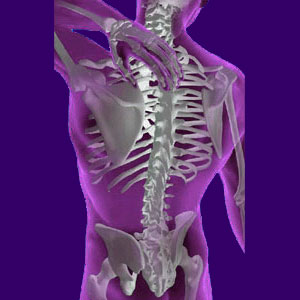
Kyphosis back pain is a chronic syndrome blamed on hyperkyphosis of the thoracic spinal region or the occasional hypokyphosis of the very same anatomical location. The thoracic spinal area is designed to demonstrate a kyphotic curvature in order to help support the considerable weight of the upper body and provide shock absorption qualities throughout the vertebral column. In essence, this curvature helps to distribute force more efficiently than a flat design.
Hyperkyphosis describes an exaggerated curvature in the upper back, while hypokyphosis means a diminished spinal curve in thoracic region. Both of these are diagnostic theories used to explain many cases of chronic upper back pain and related neurological symptomologies.
This dialog focuses on back pain and neck pain which may be sourced by an atypical degrees of kyphotic curvature in the thoracic spine.
Kyphosis Back Pain Diagnosis
The existence of a kyphotic abnormality can be easily viewed using any visual diagnostic imaging study. Many cases can be noticed with the naked eye, since they may create a hump or lump on the upper back. Many people affected by advanced hyperkyphosis have a particularly poor posture, which is indicative of the condition.
There are several reasons for kyphosis to occur including traumatic spinal injury, congenital or developmental condition, as well as advanced spinal degeneration.
Scheuermann’s kyphosis is a distinct form, while degenerative kyphosis is the most common type and is usually found in elderly patients due to porous bones, spinal arthritis and osteoporosis. Hyper and hypokyphosis can be diagnosed by degree and accurately measured much in the same way one would measure an angle.
Kyphosis Pain Conditions
Atypical kyphosis is not usually painful or problematic. Mild to moderate cases typically are asymptomatic and are not often theorized to cause symptoms, even when pain coincidentally exists.
Some care providers will blame minor kyphosis for creating upper back pain symptoms, when no other structural issue exists, but this theory rarely holds up to objective diagnostic evaluation. In these cases, the kyphosis almost always turns out to be coincidental to the pain involved in the symptomatic expression.
However, severe and extreme forms of kyphosis can become painful and even lead to the possibility for spinal instability. It is these cases which do require treatment, and sometimes even invasive surgery, to effectively resolve.
Both varieties of abnormal kyphosis can cause pain by reducing the patency of the central spinal canal or the foraminal spaces. When these events occur, the spinal cord, and/or the spinal nerve roots can suffer compression. These circumstances are well detailed in our sections covering spinal stenosis and pinched nerves.
Kyphosis Back Pain Logic
Mild to moderate cases of hyper or hypokyphosis, which are blamed for sourcing pain, are frequently misdiagnosed. In these scenarios, the symptoms may come from some yet undiagnosed structural issue, a disease process or a mindbody condition. However, the pain may also be related to the nocebo effect of the structural diagnosis, particularly if it escalates after diagnostic imaging is performed.
For advanced and extreme forms of kyphosis, the problem may well be purely structural and dire. These scenarios can be truly debilitating, although they do not need to be inherently painful. In fact, some cases of severe kyphosis, which appear terrifying, have caused no pain at all.
In all cases, it is always best to thoroughly investigate the various diagnostic possibilities, and seek out multiple professional medical opinions, before seeking any drastic or invasive care. Remember, once surgery is performed, there is no going back and real damage may now have occurred in the spinal column, which may now be truly unfixable.





